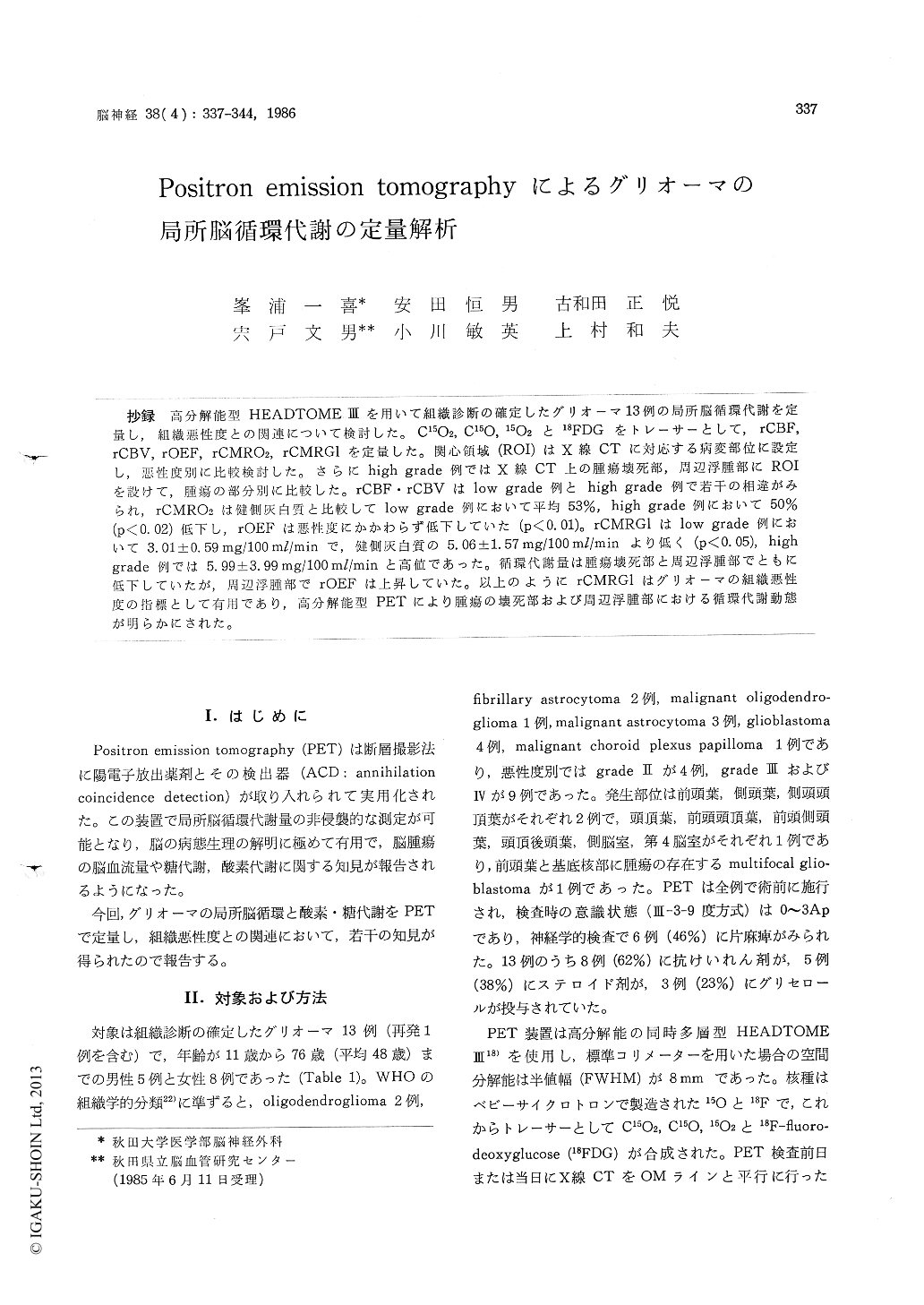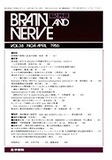Japanese
English
- 有料閲覧
- Abstract 文献概要
- 1ページ目 Look Inside
抄録 高分解能型HEADTOMEIIIを用いて組織診断の確定したグリオーマ13例の局所脳循環代謝を定量し,組織悪性度との関連について検討した。C15O2,C15O,15O2と18FDGをトレーサーとして,rCBF,rCBV,rOEF,rCMRO2,rCMRGIを定量した。関心領域(ROI)はX線CTに対応する病変部位に設定し,悪性度別に比較検討した。さらにhigh grade例ではX線CT上の腫瘍壊死部,周辺浮腫部にROIを設けて,腫瘍の部分別に比較した。rCBF・rCBVはlow grade例とhigh grade例で若干の相違がみられ,rCMRO2は健側灰白質と比較してlow grade例において平均53%,high grade例において50%(p<0.02)低下し,rOEFは悪性度にかかわらず低下していた(p<0.01)。rCMRGIはlow grade例において3.01±0.59mg/100ml/minで,健側灰白質の5.06±1.57mg/100ml/minより低く(p<0.05),highgrade例では5.99±3.99mg/100minと高値であった。循環代謝量は腫瘍壊死部と周辺浮腫部でともに低下していたが,周辺浮腫部でrOEFは上昇していた。以上のようにrCMRGIはグリオーマの組織悪性度の指標として有用であり,高分解能型PETにより腫瘍の壊死部および周辺浮腫部における循環代謝動態が明らかにされた。
A high resolution PET-HEADTOME III have been employed to quantitate regional cerebral he-modynamics and metabolism in gliomas using O-15 and 18FDG tracers, and to evaluate histologicalmalignancy preoperatively.
Hemodynamic and metabolic indices of regional cerebral blood flow (rCBF), cerebral blood volume (rCBV), oxygen consumption (rCMRO2), oxygen extraction (rOEF), and glucose consumption (rCMRGI) were studied on thirteen preoperative gliomas involving one recurrent case. Regions of interest (ROIs) on PET were placed over the cor-responding lesions in CT scans. In high grade gliomas, ROIs were also focused on the correspond-ing parts of central low density area, contrast enhanced area, and peritumoral low density area. rCBF and rCBV were variable and unrelated in both low and high grade gliomas. rCMRGI values were 5.99±3. 99 mg/100 ml/min for high grade gliomas, and 3.01 ± 0.48 mg/100 ml/min for low grade gliomas. Lesions with high uptake of radio-isotope were proved to be high grade gliomas. le-sions with low uptake being low grade gliomas. In comparison with the contralateral gray matter around the sylvian fissure, rCBV was significantly higher (p< 0.02) in high grade gliomas, and rCMRG1 was lower (p< O.05) in low grade gliomas. rCMRO2 and rOEF values were reduced markedly (p< O.01) in both low and high grade gliomas. These results support that anerobic glycolysis increased with malignancy in the metabolism of gliomas. The he-modynamics and metabolism of central low density area and peritumoral low density area reflect the pathophysiological state of necrosis and edema respectively.
PET has been a convincing tool to provide satisfactory informations on biological characteris-tics in the diagnosis of malignancy of gliomas, and should ultimately make it possible to plan an appropriate therapy.

Copyright © 1986, Igaku-Shoin Ltd. All rights reserved.


